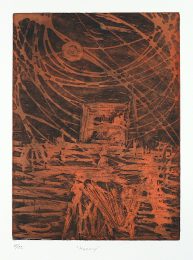

1917 - 1992
Born in Melbourne, Australia in 1917, Sidney Nolan grew up in a conservative, colonial society in the grips of a savage depression. Living on the streets and beaches around Melbourne, Nolan could have sunk without trace but instead became one of the most celebrated and influential modern artists of his generation. Nolan’s adoption of painting as a career may have been a direct result of his desire to break free from the physical and intellectual strictures of his upbringing.
Heavily influenced by the Symbolist French poet Arthur Rimbaud, Nolan rejected naturalism and realism and believed that the purpose of art was not to represent reality but to access greater truths by the ‘systematic derangement of the senses.’ The ideas encapsulated in Rimbaud’s poetry proved to be some of Nolan’s most enduring and formative influences.
Early paintings reflect his study of artists such as Pablo Picasso, Joan Miro, Wassily Kandinsky, Max Ernst and Paul Klee, who’s approach in particular appeared to resonate with Rimbaud’s ideas. Nolan was also drawn to the naïve art of Russian refugee Danila Vassilieff whose passion and reverence for art of unbridled emotion struck a chord.
Nolan emerged publicly on the art scene in 1943 and proclaimed that his art would be naïve, poetic, emotional, innovative and completely experimental and guided by the principle, expressed by Rimbaud, ‘Il faut être absolument modern’ (one must be absolutely modern).
Between 1946 and 1947 Nolan painted his first series of works that commented on the life of the Australian bandit Ned Kelly. Nolan’s starkly simplified depiction of Kelly in his homemade armour and boxed head has become an iconic Australian image and became a symbol and constantly recurring theme in Nolan’s work. This was the first chapter of an Epic Poem for Nolan that continued to absorb him until his last painting in 1992. ‘It’s mostly to do with a poetic view of life’, he said, ‘something one might call the reconciliation between experience and ideals.’
Nolan moved to England in 1955, but he continued to paint his native Australian landscapes, among other themes. He became an artist for whom the expression of emotion and the emotional punch of his work was everything. He painted in series, like visual poems which are at their most profound when exhibited together – and the poems are complete.
Throughout his lifetime, Nolan collaborated with writers, poets and musicians and worked on numerous stage set designs including Igor Stravinsky’s ballet The Rite of Spring, London 1962 and Camille Saint-Saën’s opera Samson et Dalila, London 1981.
Nolan finally settled at The Rodd in rural Herefordshire where he set up The Sidney Nolan Trust in 1985. His vision was an inspirational gathering place for artists, scholars, students and others, to meet, exchange ideas, and create. When he died in 1992, he bequeathed a legacy of paintings, property, farmland, woodland, and his ambitions for the future of the Trust.
Sidney Nolan was knighted in 1981 and awarded the Order of Merit in 1983. He was also made a Companion of the Order of Australia, elected an honorary member of the American Academy of Arts and Letters and a member of The Royal Academy of Arts.